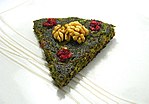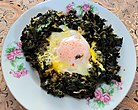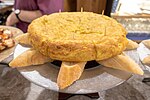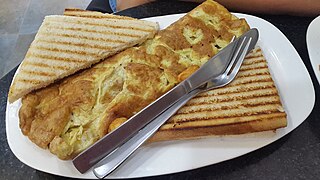Omelette
 Bacon, cheese and onion omelette | |
| Alternative names | Omelet, egg pancake |
|---|---|
| Place of origin | Ancient Persia/Iran[1][2] |
| Serving temperature | Hot |
| Main ingredients | Eggs, butter or oil |
An omelette (sometimes omelet in American English; see spelling differences) is a dish made from eggs, fried with butter or oil in a frying pan. It is a common practice for an omelette to include fillings such as chives, vegetables, mushrooms, meat (often ham or bacon), cheese, onions or some combination of the above. Whole eggs or egg whites are often beaten with a small amount of milk, cream, or water.
History
[edit]
The earliest omelettes are believed to have originated in ancient Persia.[1][2]: 65 According to Breakfast: A History, they were "nearly indistinguishable" from the Iranian dish kookoo sabzi.[2]
According to Alan Davidson,[1] the French word omelette (French: [ɔm.lɛt]) came into use during the mid-16th century, but the versions alumelle and alumete are employed by the Ménagier de Paris (II, 4 and II, 5) in 1393.[3] Rabelais (Gargantua and Pantagruel, IV, 9) mentions an homelaicte d'oeufs,[4] Olivier de Serres an amelette, François Pierre La Varenne's Le cuisinier françois (1651) has aumelette, and the modern omelette appears in Cuisine bourgeoise (1784).[5]
Alexandre Dumas discusses several variations of omelette in his Grand dictionnaire de cuisine. One is an omelette with fresh herbs (parsley, chives and tarragon), another is a variation with mushrooms that Dumas says may be adapted using green peas, asparagus, spinach, sorrel or varieties of truffles. The "kirsch omelette " (or rum omelette) is a sweet omelette made with sugar and liquor, either kirsh or rum. The omelette is rolled and sprinkled with powdered sugar. A hot poker is used to burn a design into the omelette and it is served with a sweet sauce made of liquor and apricot jam. Another sweet omelette, attributed to a royal cook of Prussia, is made with apples and brown sugar glaze. Of the Arabian omelette, Dumas writes "I have been concerned in this book to give the recipes of peoples who have no true cuisine. Here, for example, is a recipe the Bey's cook was good enough to give me." The omelette itself is made with an ostrich egg and served with a spicy tomato-pepper sauce.[6]
Variations by country
[edit]| Nutritional value per 100 g (3.5 oz) | |||||||||||||||||||||||||||||||||||||||||||||||||||||
|---|---|---|---|---|---|---|---|---|---|---|---|---|---|---|---|---|---|---|---|---|---|---|---|---|---|---|---|---|---|---|---|---|---|---|---|---|---|---|---|---|---|---|---|---|---|---|---|---|---|---|---|---|---|
| Energy | 657 kJ (157 kcal) | ||||||||||||||||||||||||||||||||||||||||||||||||||||
0.7 g | |||||||||||||||||||||||||||||||||||||||||||||||||||||
12 g | |||||||||||||||||||||||||||||||||||||||||||||||||||||
10.6 g | |||||||||||||||||||||||||||||||||||||||||||||||||||||
| |||||||||||||||||||||||||||||||||||||||||||||||||||||
| Other constituents | Quantity | ||||||||||||||||||||||||||||||||||||||||||||||||||||
| Water | 75.9 g | ||||||||||||||||||||||||||||||||||||||||||||||||||||
| Cholesterol | 356 mg | ||||||||||||||||||||||||||||||||||||||||||||||||||||
| †Percentages estimated using US recommendations for adults,[7] except for potassium, which is estimated based on expert recommendation from the National Academies.[8] | |||||||||||||||||||||||||||||||||||||||||||||||||||||
China
[edit]- Egg foo young, a Cantonese omelette made with beaten eggs and usually ham.[9]
- An oyster omelette, a dish of Hokkien and Teochew origin made with oysters, starch and egg batter
France
[edit]- Depending on sources, a standard omelette is cooked in butter on medium (or sometimes high[10]) heat,[11] is supposed to be golden brown[10] or "unbrowned or very lightly browned"[11] on the outside and soft in the inside[10] (though variations are possible according to preferences[11]); according to some American cookbooks reflecting high-end restaurant practices, a "French Omelette" should be unbrowned, cooked slowly over medium-low to medium heat, with initial stirring to prevent curds and sticking.[12] Seasoned with just salt and pepper, this omelette is often flavored with finely chopped herbs (often fines herbes[13] or tarragon, chervil, parsley and chives) or chopped onions.
- The omelette de la mère Poulard, a Norman specialty first developed in Mont-Saint-Michel, has been called the most famous omelette in the world. It is served without fillings but often served with heavy garnishes.[14]
- The Provençal omelette is more similar to a frittata than to a traditional rolled or folded French omelette.[15] The eggs are cooked like a traditional French omelette until the time any fillings are added; instead of adding fillings in a strip or on half the omelette, they are scattered over the entire surface of the omelette, and then the entire omelette is flipped and slipped back into the pan to cook what had been the top and is now the bottom.[15] A tourne omelette or vire omelette, a concave platter similar to a cake plate, is often used as an aid and can be used to serve the finished omelette.[15] According to Bernard Duplessy the tourne omelette dates to "several centuries before Christ".[15]
- Crespéou, another Provençal dish (also called gateau d'omelettes or omelettes en sandwich), is made by stacking open-faced omelettes.[16][17]
-
Blond unbrowned omelet with mushrooms and herbs
India
[edit]- In Parsi cuisine, pora is an omelette made from eggs, onion, tomato, green chillies, and coriander leaves.[18] It is usually served for breakfast with Indian/Irani tea and bread.

- In India, eggs are beaten with onions and poured directly on a hot pan with salt and pepper. These omelettes are consumed frequently in many Indian households.
- Bread Omlette, a widespread indian snack made with Bread and egg is famous across India.

- In South Indian hotels, omlette is mixed with the mutton gravy (salna) in a semi-cooked manner and many omlette variants like Kalakki, Plain Omlette, Karandi Omlette, Podi Omlette are widespread found in Tamilnadu.
Indonesia
[edit]- In Betawi cuisine, kerak telor is a traditional spicy omelette that made from glutinous rice cooked with egg and served with serundeng (fried shredded coconut), fried shallots and dried shrimp as topping.
- Fuyunghai or puyonghai is a Chinese Indonesian omelette, usually made from the mixture of vegetables such as carrots, bean sprouts, and cabbages, mixed with meats such as crab, shrimp, or minced chicken.
Iran
[edit]- Kuku is an omelette frequently containing large proportions of other ingredients, including herbs, folded in.
- Nargesi or spinach omelette is an Iranian dish, made with fried onions and spinach, and is spiced with salt, garlic, and pepper.[19][20]
-
Iranian omelette with tomato
Italy
[edit]- A frittata is an open-faced Italian omelette-like dish that can contain cheese, vegetables, or even leftover pasta. Frittatas are cooked slowly. Except for the cooking oil, all ingredients are fully mixed with the eggs before cooking starts.
Japan
[edit]- In Japan, tamagoyaki is a traditional omelette in which eggs are beaten with mirin, soy sauce, bonito flakes, sugar and water, and cooked in a special rectangular frying pan.
- Omurice (from the French word "omelette" and English word "rice") is an omelette filled with fried rice and usually served with a large amount of tomato ketchup. Omu-soba is an omelette with yakisoba as its filling. There are several styles of this dish, including omelette cooked and filled with fried rice, a soft-cooked omelette served over the fried rice that is then sliced open, and a "tornado" style omelette over the rice.
- Tenshindon is a Japanese-Chinese specialty, consisting of a crab meat omelette on rice.[21]
Korea
[edit]In Korean cuisine, traditional omelettes are known as gyeran-mari (계란말이, "rolled-eggs") which is a type of savory banchan. Gyeran-mari is made with beaten eggs, mixed with finely diced vegetables, meats, and seafood. This side dish is often found in Korean banquet (janchi) meals, as well as Korean fast food (bunsik) restaurants.
Mexico and Central America
[edit]While the Spanish terms tortilla (in Spain) and torta (in the Philippines) are applied to an omelette dish, in Mexico & Central America tortilla is a term for a flatbread made of wheat or corn, while torta is used for a type of sandwich. An omelette in Mexico (& Central America) is sometimes termed as tortilla de huevos, but the term omelette is widely used.[citation needed]
Philippines
[edit]In the Philippines, omelettes are known as torta, usually encountered with the enclitic -ng ("tortang") indicating it modifies the next word (the main ingredient); e.g. tortang hipon = torta ("omelette") + -ng and hipon ("shrimp"), meaning "shrimp omelette". There are many types of torta which are named based on their main ingredients. They include:
- Tortang alamang or tortang hipon[22] – an omelette with krill or small shrimp. Also known as shrimp fritters,[23] although this term usually refers to okoy, a fritter made with shrimp and various vegetables (as well as other variations without shrimp).
- Tortang carne norte – an omelette made from corned beef mixed with eggs. A common cheap breakfast dish.
- Tortang dulong or maranay – an omelette, usually crispy, made with tiny fish from the family Salangidae known as dulong in Tagalog and ipon, libgao, or maranay in Visayan.[24][25] It is sometimes called okoy, though traditional okoy is not an omelette, but rather a type of fritter made with glutinous rice.
- Tortang giniling or tortang picadillo – an omelette with ground meat (usually beef or pork) and sautéed vegetables.[26]
- Tortang gulay – an omelette with peppers, mushrooms, onion, and garlic.
- Tortang kalabasa – an omelette made with finely julienned calabaza, eggs, flour, and salt.
- Tortang kamote – an omelette made with mashed sweet potato, eggs, flour, and salt.
- Tortang sardinas – an omelette made with shredded canned smoked sardines (tinapa)[27]
- Tortang talong – an eggplant omelet with whole grilled eggplants. Versions stuffed with ground meat (giniling) and vegetables are called relyenong talong.
Pontic Greeks
[edit]- Foustoron is an omelette made by the Pontic Greeks.[28] Foustoron is made with eggs fried in butter or oil; the omelette can be served plain or seasoned. Some modern varieties include yogurt and cheese. The recipe varied widely by region: some recipes included onion and dried red peppers, while others did not.[citation needed]
Spain
[edit]- The Spanish tortilla de patatas, or tortilla española in other Spanish-speaking countries, is a traditional and very popular thick omelette containing sliced potatoes sautéed in cooking oil. It often includes sliced onions (tortilla de patata con cebolla) and less commonly other additional fillings, such as cheese, bell peppers, or diced ham.
Thailand
[edit]- In Thai cuisine, a traditional omelette is called khai chiao ไข่เจียว (khai meaning "egg", and chiao meaning oil-fried), in which the beaten egg mixture and a small quantity of fish sauce is deep fried in a wok filled with 1-2 cups of vegetable oil and served over steamed rice. The dish is usually served with Sriracha sauce and cilantro. A variation on this dish is khai chiao songkhrueang, where the plain egg omelette is served together with a stir-fry of meat and vegetables. Yet another type of Thai omelette is khai yat sai, literally "eggs filled with stuffing".[29]
United Kingdom
[edit]An omelette Arnold Bennett incorporates smoked haddock, hard cheese (typically Cheddar), and cream.[30] It was created by the chef Jean Baptiste Virlogeux at the Savoy Grill in London for the writer Arnold Bennett, who was a frequent customer.[30][31] Cooks from Marcus Wareing to Delia Smith and Gordon Ramsay have published recipes for it.[32]
United States
[edit]- A Denver omelette, also known as a Southwest omelette or Western omelette,[33] is an omelette filled with diced ham, onions, and green bell peppers,[34][citation needed] though there are many variations on fillings. Often served in the Southwestern United States, this omelette sometimes has a topping of cheese and a side dish of hash browns or fried potatoes.[35]
- A hangtown fry, containing bacon and breaded oysters, is an omelette that originated in Placerville, California, during the Gold Rush.
- An egg white omelette is a variation which omits the yolks to remove fat and cholesterol,[36] which reside exclusively in the yolk portion of an egg.
Gallery
[edit]-
Bitter melon omelette, a common dish in Southeast Asia
-
An omelette foldover
-
Masala omelette with bread toasties
-
Vegetable omelette
See also
[edit]References
[edit]- ^ a b c Davidson, Alan (August 21, 2014). The Oxford Companion to Food. OUP Oxford. p. 571. ISBN 9780191040726. Archived from the original on July 1, 2021. Retrieved November 18, 2020.
- ^ a b c Anderson, Heather Arndt (July 11, 2013). Breakfast: A History. AltaMira Press. p. 65. ISBN 9780759121652. Archived from the original on July 1, 2021. Retrieved November 18, 2020.
- ^ ""Omelette"". Archived from the original on March 5, 2014. Retrieved April 9, 2009.
- ^ "En pareille alliance, l'un appeloit une sienne, mon homelaicte. Elle le nommoit mon oeuf, et estoient alliés comme une homelaicte d'oeufs".
- ^ Three noted by Maguelonne Toussaint-Samat, (Anthea Bell, tr.) A History of Food, revised ed, 2009, p. 326; de Serres note "Le glossaire accadien" Archived July 19, 2011, at the Wayback Machine
- ^ Alexandre Dumas' Dictionary of Cuisine, 1873
- ^ United States Food and Drug Administration (2024). "Daily Value on the Nutrition and Supplement Facts Labels". FDA. Archived from the original on 2024-03-27. Retrieved 2024-03-28.
- ^ National Academies of Sciences, Engineering, and Medicine; Health and Medicine Division; Food and Nutrition Board; Committee to Review the Dietary Reference Intakes for Sodium and Potassium (2019). "Chapter 4: Potassium: Dietary Reference Intakes for Adequacy". In Oria, Maria; Harrison, Meghan; Stallings, Virginia A. (eds.). Dietary Reference Intakes for Sodium and Potassium. The National Academies Collection: Reports funded by National Institutes of Health. Washington, DC: National Academies Press (US). pp. 120–121. doi:10.17226/25353. ISBN 978-0-309-48834-1. PMID 30844154. Retrieved 2024-12-05.
- ^ "Egg Foo Young (Chinese Omelette)". 23 February 2019. Retrieved May 19, 2024.
- ^ a b c Ginette Mathiot (éd), La Cuisine pour tous, 1955, p.107 : "(...) laissez cuire à feu vif. L'omelette doit être dorée à l'extérieur, baveuse au centre."
- ^ a b c Terese Allen (1991). The Ovens of Brittany Cookbook. The Guest Cottage, Inc. pp. 79–. ISBN 978-0-942495-11-9. Archived from the original on July 1, 2021. Retrieved August 31, 2019.
- ^ "How to Perfect the French Omelet (Hint: There Will Be Butter)". Bon Appétit. March 27, 2017. Archived from the original on June 27, 2019. Retrieved June 27, 2019.
- ^ Julia Child, Bertholle, L., Beck, S., Mastering the Art of French Cooking (Vol. I), page 135, Knopf, 1961
- ^ Cloake, Felicity (June 4, 2019). "Bon appétit! How I rediscovered the joys of French cuisine". The Guardian. ISSN 0261-3077. Archived from the original on September 2, 2019. Retrieved October 2, 2019.
- ^ a b c d Wolfert, Paula (2009). Mediterranean clay pot cooking: traditional and modern recipes to savor and share. Hoboken, N.J.: John Wiley & Sons. pp. 280–281. ISBN 978-0-7645-7633-1. OCLC 298538015.
- ^ Schrambling, Regina (2007-07-11). "Ratatouille? Mais non! (pt. 1)". The Los Angeles Times. p. 52. Retrieved 2022-01-23.
- ^ Schrambling, Regina (11 July 2007). "Edible ticket to Provence. Crespeou Ratatouille part 2". Los Angeles Times. Retrieved 2022-01-23.
- ^ King, Niloufer Ichaporia (June 18, 2007). My Bombay Kitchen: Traditional and Modern Parsi Home Cooking. University of California Press. ISBN 9780520933378. Archived from the original on July 1, 2021. Retrieved November 18, 2020.
- ^ "آشنایی با روش تهیه نرگسی؛ غذای رژیمی". Hamshahri newspaper. 12 December 2011. Archived from the original on September 30, 2013. Retrieved September 19, 2013.
- ^ "SPINACH OMELETTE". Archived from the original on September 22, 2013. Retrieved September 19, 2013.
- ^ Itoh, Makiko (September 14, 2019). "Tenshinhan: A made-in-Japan omelette with Chinese influences". The Japan Times. Archived from the original on October 6, 2019. Retrieved October 6, 2019.
- ^ "CRISPY TORTANG ALAMANG OR HIPON RECIPE". October 4, 2021. Archived from the original on December 17, 2021. Retrieved December 17, 2021.
- ^ "Small Shrimps Fritters (Tortang Alamang)". March 19, 2019.
- ^ "Tortang Dulong Recipe". Panlasang Pinoy. 18 August 2010. Archived from the original on June 9, 2020. Retrieved June 9, 2020.
- ^ "15 Filipino Foods I Bet You Haven't Tried in the Philippines!". BecomingFilipino. 4 March 2015. Archived from the original on June 9, 2020. Retrieved June 9, 2020.
- ^ Merano, Manjo (14 June 2010). "Tortang Giniling Recipe". Pansalang Pinoy. Archived from the original on February 14, 2015. Retrieved February 12, 2015.
- ^ "Tortang Sardinas ( Sardines Omelette)". Pinoy Cooking Recipes. Retrieved 10 December 2021.
- ^ Thomai Kiziridou (2007). Pontian Delicacies (in Greek). Kyriakidis. p. 380. ISBN 978-960-343-648-5.
- ^ "Kai Yat Sai Talay (Thai Omelette With Seafood) Recipe". Food.com. March 4, 2008. Archived from the original on October 6, 2019. Retrieved October 6, 2019.
- ^ a b Ayto, John. "Arnold Bennett", The Diner's Dictionary, Oxford University Press, 2012. Retrieved 3 June 2020 (subscription required) Archived 3 June 2020 at the Wayback Machine
- ^ Rhodes, Gary. "Omelette Arnold Bennett" Archived 3 June 2020 at the Wayback Machine, New British Classics. Retrieved 3 June 2020.
- ^ "Marcus Wareing's omelette Arnold Bennett" Archived 3 June 2020 at the Wayback Machine. Delicious; "Easy Omelette Arnold Bennett" Archived 9 November 2019 at the Wayback Machine, Delia Online; and "Savoy Grill Arnold Bennett Omelette Recipe" Archived 4 June 2020 at the Wayback Machine, Gordon Ramsay Restaurants. Retrieved 3 June 2020.
- ^ Ayto, J. (2012). The Diner's Dictionary: Word Origins of Food and Drink. Oxford Quick reference collection. OUP Oxford. p. 115. ISBN 978-0-19-964024-9. Archived from the original on July 1, 2021. Retrieved October 6, 2019.
- ^ of, S.T.; Oseland, J. (2014). Saveur: The New Classics Cookbook: More Than 1,000 of the World's Best Recipes for Today's Kitchen. Weldon Owen. p. 124. ISBN 978-1-61628-735-1. Archived from the original on February 6, 2020. Retrieved October 6, 2019.
- ^ "Denver Omelette Scrambler". Archived from the original on July 16, 2011. Retrieved December 30, 2010.
- ^ Brewer, S.; Siple, M. (2011). Low-Cholesterol Cookbook For Dummies. Wiley. p. pt94. ISBN 978-1-119-99679-8. Archived from the original on July 1, 2021. Retrieved October 6, 2019.
























